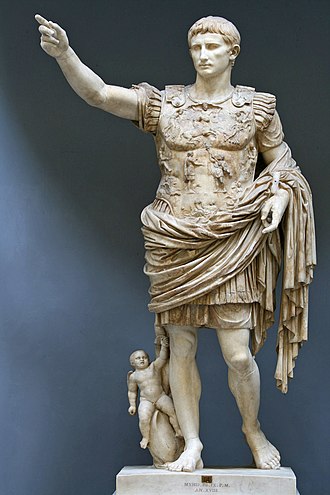Julio-Claudian dynasty





Julio-Claudian dynasty refers to the first Imperial dynasty of Ancient Rome, which ruled from 27 BC until AD 68. The dynasty is named after its two most illustrious members, Julius Caesar and Augustus (born Gaius Octavius, also known as Octavian), who were both from the Julian clan, and Tiberius, Caligula (also known as Gaius), Claudius, and Nero from the Claudian family. This period was marked by the transformation of the Roman Republic into the Roman Empire and is noted for its relative internal peace, economic prosperity, and significant expansion.
Founding[edit]
The foundation of the Julio-Claudian dynasty was laid by Julius Caesar, a military general and statesman, who was assassinated in 44 BC. His adopted heir, Octavian, later known as Augustus, emerged victorious from a series of civil wars and was awarded the title of "Augustus" by the Roman Senate in 27 BC, marking the beginning of the Roman Empire and the end of the Roman Republic.
Rulers[edit]
- Augustus (27 BC – AD 14): The first emperor of Rome, Augustus established the principate, the system of monarchy headed by an emperor holding power for life. His reign brought about a period of unprecedented peace and prosperity known as the Pax Romana.
- Tiberius (AD 14 – 37): Stepson and successor of Augustus, Tiberius' reign was marked by a notable withdrawal from public life towards the end, leading to governance issues and the rise of the Praetorian Guard's power.
- Caligula (AD 37 – 41): Known for his eccentricity and tyrannical rule, Caligula's assassination led to the brief establishment of a republic before it was quashed by the next emperor, Claudius.
- Claudius (AD 41 – 54): Claudius expanded the Roman Empire to include Mauretania, Thrace, and Britain, and made significant improvements to the Roman legal system and administrative governance.
- Nero (AD 54 – 68): The last Julio-Claudian emperor, Nero's rule is often associated with tyranny, extravagance, and the Great Fire of Rome in AD 64. His death ended the Julio-Claudian dynasty and led to a brief period of civil wars known as the Year of the Four Emperors.
Impact and Legacy[edit]
The Julio-Claudian dynasty laid the foundations for the Roman Empire, establishing administrative structures, a centralized government, and expanding the empire's boundaries. Their rule also saw the flourishing of Roman culture, including literature, architecture, and the arts. However, the dynasty was also marked by autocratic rule, succession crises, and instances of extreme extravagance and personal decadence that would become emblematic of the challenges facing Roman imperial governance.
Decline and Fall[edit]
The dynasty came to an end with the suicide of Nero in AD 68, following a year of revolt and civil unrest. His death led to the Year of the Four Emperors, a brief period of civil war that ultimately resulted in the establishment of the Flavian dynasty under Vespasian.

This article is a ancient Rome–related stub. You can help WikiMD by expanding it!
Ad. Transform your life with W8MD's Budget GLP-1 injections from $75


W8MD offers a medical weight loss program to lose weight in Philadelphia. Our physician-supervised medical weight loss provides:
- Weight loss injections in NYC (generic and brand names):
- Zepbound / Mounjaro, Wegovy / Ozempic, Saxenda
- Most insurances accepted or discounted self-pay rates. We will obtain insurance prior authorizations if needed.
- Generic GLP1 weight loss injections from $75 for the starting dose.
- Also offer prescription weight loss medications including Phentermine, Qsymia, Diethylpropion, Contrave etc.
NYC weight loss doctor appointmentsNYC weight loss doctor appointments
Start your NYC weight loss journey today at our NYC medical weight loss and Philadelphia medical weight loss clinics.
- Call 718-946-5500 to lose weight in NYC or for medical weight loss in Philadelphia 215-676-2334.
- Tags:NYC medical weight loss, Philadelphia lose weight Zepbound NYC, Budget GLP1 weight loss injections, Wegovy Philadelphia, Wegovy NYC, Philadelphia medical weight loss, Brookly weight loss and Wegovy NYC
|
WikiMD's Wellness Encyclopedia |
| Let Food Be Thy Medicine Medicine Thy Food - Hippocrates |
Medical Disclaimer: WikiMD is not a substitute for professional medical advice. The information on WikiMD is provided as an information resource only, may be incorrect, outdated or misleading, and is not to be used or relied on for any diagnostic or treatment purposes. Please consult your health care provider before making any healthcare decisions or for guidance about a specific medical condition. WikiMD expressly disclaims responsibility, and shall have no liability, for any damages, loss, injury, or liability whatsoever suffered as a result of your reliance on the information contained in this site. By visiting this site you agree to the foregoing terms and conditions, which may from time to time be changed or supplemented by WikiMD. If you do not agree to the foregoing terms and conditions, you should not enter or use this site. See full disclaimer.
Credits:Most images are courtesy of Wikimedia commons, and templates, categories Wikipedia, licensed under CC BY SA or similar.
Translate this page: - East Asian
中文,
日本,
한국어,
South Asian
हिन्दी,
தமிழ்,
తెలుగు,
Urdu,
ಕನ್ನಡ,
Southeast Asian
Indonesian,
Vietnamese,
Thai,
မြန်မာဘာသာ,
বাংলা
European
español,
Deutsch,
français,
Greek,
português do Brasil,
polski,
română,
русский,
Nederlands,
norsk,
svenska,
suomi,
Italian
Middle Eastern & African
عربى,
Turkish,
Persian,
Hebrew,
Afrikaans,
isiZulu,
Kiswahili,
Other
Bulgarian,
Hungarian,
Czech,
Swedish,
മലയാളം,
मराठी,
ਪੰਜਾਬੀ,
ગુજરાતી,
Portuguese,
Ukrainian